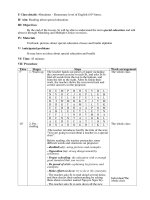marketing princiles unit 3 market segment, target
Bạn đang xem bản rút gọn của tài liệu. Xem và tải ngay bản đầy đủ của tài liệu tại đây (3.06 MB, 27 trang )
Unit 3
Market Segmentation,
g
Targeting,
g
g and
Positioning for Competitive Advantage
1
CuuDuongThanCong.com
/>
Road Map: Previewing the
Concepts
Define the three steps of target marketing:
market segmentation, market targeting, and
market positioning.
List and discuss the major levels of market
segmentation and bases for segmenting
consumer and business markets.
Explain how companies identify attractive
market segments and choose a market
coverage strategy
strategy.
Discuss how companies can position their
products for maximum competitive
p
p
advantage in the marketplace.
2
CuuDuongThanCong.com
/>
Steps in Market Segmentation,
Targeting and Positioning
Targeting,
3
CuuDuongThanCong.com
/>
Si St
Six
Step STP P
Process
1.
2
2.
3.
4
4.
5.
6.
Determine the segmentation basis
Segment the Market
Profile each segment
Assess segment attractiveness
Select target segments
D t
Determine
i positioning
iti i
4
CuuDuongThanCong.com
/>
Step 1.
1 Market Segmentation
Levels of Market Segmentation
Dividing
d
Markets
k
into Smaller
S ll Segments
S
that
h Can
C be
b
Reached More Efficiently And Effectively With Products
and Services That Match Their Unique Needs.
Needs
Mass Marketing
S
Same
product
d t tto allll consumers
(no segmentation, i.e Coca-Cola at one time)
S
Segment
tM
Marketing
k ti
Different products to one or more segments
(some segmentation, i.e. Marriott)
5
CuuDuongThanCong.com
/>
Step 1. Market Segmentation
Levels of Market Segmentation
Niche Marketing
Different products to subgroups within segments
(more segmentation, i.e. Standard or Luxury SUV
SUV’s)
s)
Micromarketing
Products to suit the tastes of individuals and locations
(complete segmentation)
Local Marketing
Tailoring brands/promotions to
l
local
l customer
t
groups
Individual Marketing
Tailoring products and
programs to the needs of
individual customers
6
CuuDuongThanCong.com
/>
Step 1. Market Segmentation
Geographic Segmentation
World Region or Country
City or Metro Size
Density or Climate
7
CuuDuongThanCong.com
/>
Step 1.
1 Market Segmentation
Demographic Segmentation
Dividing the market into
groups based on variables
such as:
–
–
–
–
–
–
–
–
–
Age
Life-cycle stage or family size
Gender
Income
Occupation
Education
Religion
Race
Nationality
8
CuuDuongThanCong.com
/>
Step 1. Market Segmentation
Psychographic Segmentation
Di id Buyers
Divides
B
Into
I
Different
Diff
G
Groups B
Based
dO
On:
9
CuuDuongThanCong.com
/>
Step 1.
1 Market Segmentation
Behavioral Segmentation
Dividing the market into
groups
g
p based on variables
such as:
– Occasions
– Benefits sought
– User status
– Usage rate
– Loyalty status
10
CuuDuongThanCong.com
/>
There are many ways to segment a
g the four segmentation
g
market. Using
variables (Geographic, Demographic,
Psychographic & Behavioral), discuss
which variables would be most
important for segmenting:
– drivers of a proposed new sports car.
Explain your choices.
11
CuuDuongThanCong.com
/>
Segmenting Business Markets
Operating Characteristics
Purchasing Approaches
Business
Marketers Use
Many of the
Same Consumer
Variables Plus:
Variables,
Situational Factors
Personal Characteristics
12
CuuDuongThanCong.com
/>
Segmenting International
Markets
Geographic
Location
Factors Used
to Segment
g
International
Markets
Cultural
Factors
Economic
Factors
Political and
Legal Factors
13
CuuDuongThanCong.com
/>
Step 1.
1 Market Segmentation
Requirements for Effective Segmentation
Measurable: size,
purchasing power, and
profiles of segments
p
g
can be measured.
Accessible: segments
can be effectivelyy
reached and served.
Substantial:
segments are large or
profitable enough to
serve.
Differential: segments
are conceptually
distinguishable and
respond differently to
different marketing mix
elements and
programs.
Actionable: effective
programs can be
designed for attracting
and serving the
segments.
14
CuuDuongThanCong.com
/>
Step 2. Market Targeting
Evaluating Market Segments
Segment Size and Growth
– Analyze current segment sales, growth rates, and
expected profitability for various segments.
Segment Structural Attractiveness
– Consider effects of: competitors, availability of
substitute products
products, and the power of buyers &
suppliers.
Company Objectives and Resources
– Examine company skills & resources needed to
succeed in that segment(s).
– Offer superior
p
value & g
gain advantages
g over
competitors.
15
CuuDuongThanCong.com
/>
Step 2. Selecting Market Segments
Market Coverage Strategies
16
CuuDuongThanCong.com
/>
Step 22. Selecting Market Segments
Choosing a Market-Coverage Strategy
Company Resources
Product Variability
Product’s Life-Cycle Stage
Market Variability
Competitors’ Marketing Strategies
Competitors
17
CuuDuongThanCong.com
/>
Socially Responsible Target
Marketing
Smart targeting helps companies and
consumers alike.
Target marketing sometimes generates
controversy and concern.
– Disadvantaged and vulnerable can be
targeted.
– Ce
Cereal,
ea , cigarette,
c ga ette, bee
beer,, a
and
d fast-food
ast ood
marketers have received criticism in the past.
– Internet has raised fresh concerns about
potential targeting abuses.
18
CuuDuongThanCong.com
/>
Step 3.
3 Positioning for
Competitive Advantage
Product’s Position - the way the product is
defined by consumers on important attributes.
P d t is
Product
i compared
d with
ith competing
ti products.
d t
Simplifies the buying process by helping
consumers organize products into categories
categories.
Marketers must:
– Plan positions to give their products the greatest
advantage in selected target markets,
– Design marketing mixes to create these planned
positions.
19
CuuDuongThanCong.com
/>
Step 3. Choosing a Positioning
Strategy
Step 1. Identifying
Possible Competitive
Advantages
Step 2. Choosing the
Right
g t Co
Competitive
pet t e
Advantage
Step
p 3. Communicating
g
and Delivering the
Chosen Position
20
CuuDuongThanCong.com
/>
Identifying Possible
Competitive Advantages
Key to winning and keeping customers
is to understand their needs and
buying processes better than
competitors do and deliver more value.
Competitive advantage – extent that a
company can position itself as
providing
idi superior
i value
l to selected
l
d
target markets.
21
CuuDuongThanCong.com
/>
Identifying Possible
Competitive Advantages
Product
Differentiation
ii.e.
e Features,
Features Performance
Performance,
Style & Design, Attributes
Image
Differentiation
Services
Differentiation
ii.e.
e Delivery,
Delivery Installation,
Installation
Repair Services, Customer
Training Services
Channel
Differentiation
i.e. Symbols, Characters
People
Differentiation
i.e. Hiring, Training Better
People Than Competitors
Do
22
CuuDuongThanCong.com
/>
Vol o
Volvo
This ad demonstrates how Volvo positions on
the specific product attribute of safety
safety.
23
CuuDuongThanCong.com
/>
Choosing the Right Competitive
Advantages
Important
Profitable
Criteria
For Determining
Which Differences
To Promote
Affordable
Preemptive
Distinctive
Superior
p
Communicable
24
CuuDuongThanCong.com
/>
Selecting an Overall
Positioning Strategy
25
CuuDuongThanCong.com
/>









